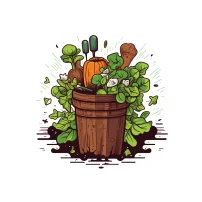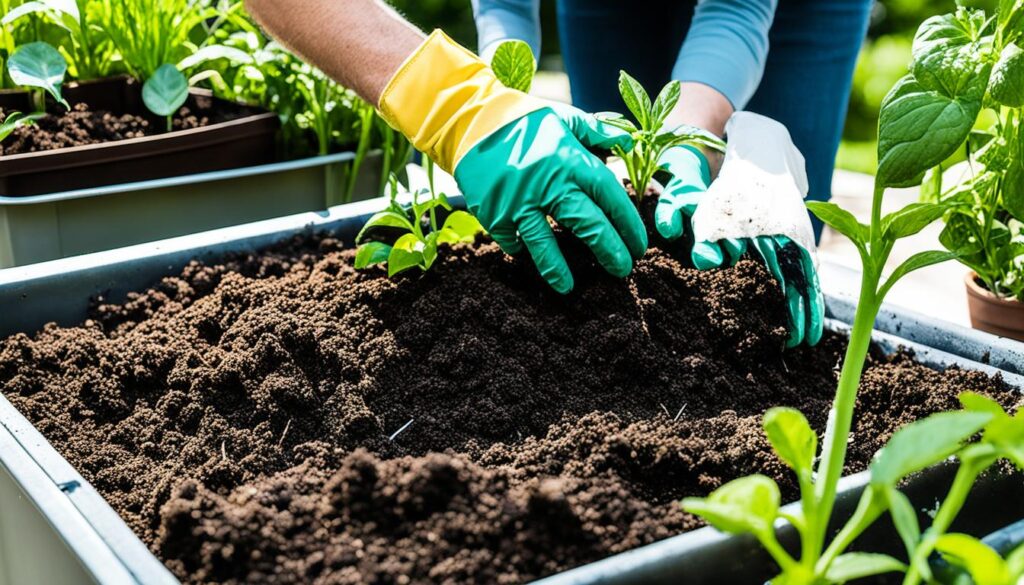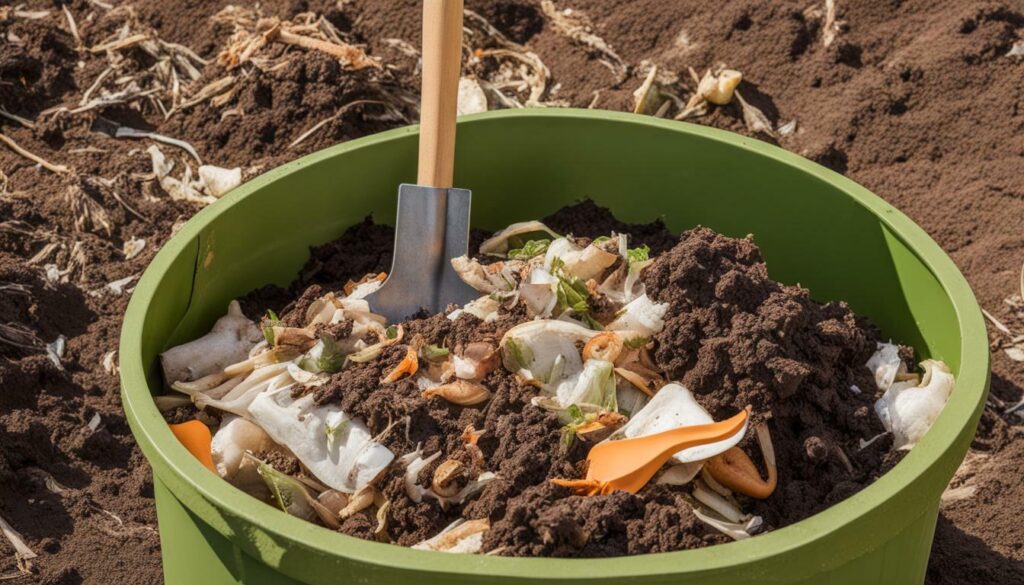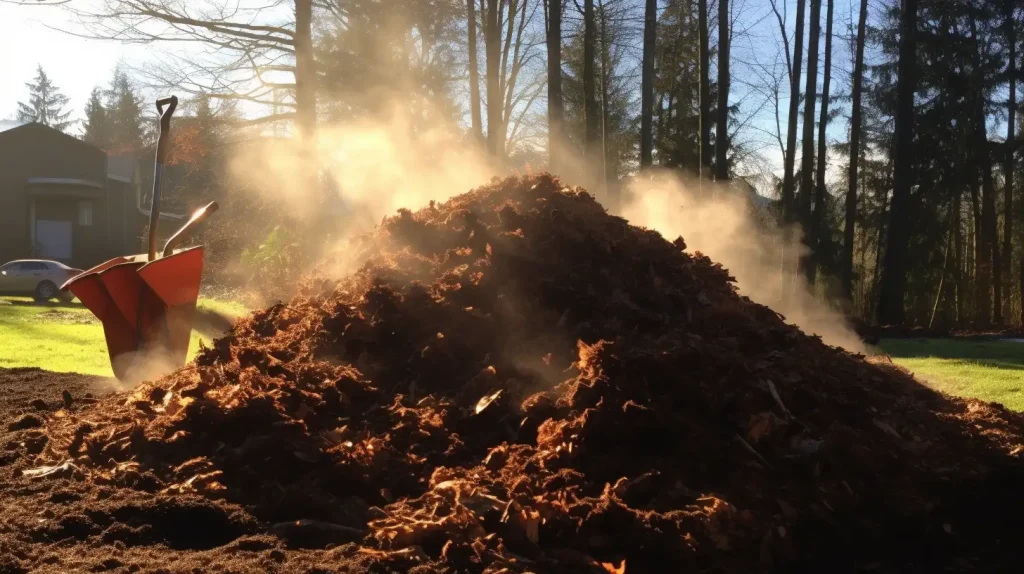To manage mold in compost effectively, it’s essential to understand that mold presence is a natural part of the composting process, breaking down organic matter alongside bacteria and fungi. Nevertheless, excessive mold growth can indicate imbalances in moisture, air circulation, or the carbon-to-nitrogen ratio. To mitigate mold, ensure your compost is properly aerated by turning it regularly, which enhances oxygen supply and disrupts mold growth. Adjust the moisture levels by adding dry, carbon-rich “browns” like leaves or straw if the compost is too wet, or moisten it if too dry. Balancing green nitrogen-rich materials with browns helps maintain an optimal environment for decomposition while minimizing mold overgrowth. Monitoring and adjusting these elements as needed promotes healthy composting processes without excessive mold issues.
We’ll now take a look at this topic in a little more detail…
Did you know that mold can be a common concern in compost? In fact, mold growth in compost is not only normal but also essential for the decomposition process. However, excessive mold growth can indicate an imbalance in your compost pile and may raise concerns. To ensure a healthy and productive composting process, it’s crucial to understand how to manage mold effectively and prevent its overgrowth.
In this article, we will guide you through the process of handling mold in your compost pile, provide tips for preventing excessive mold growth, and address common concerns regarding mold in compost. By the end, you’ll have the knowledge to create a thriving compost ecosystem while minimizing mold-related issues.
Key Takeaways:
- Understanding the roles of mold in composting
- Identifying healthy mold in compost
- Effective techniques for handling and managing mold in compost
- Preventing excessive mold growth through proper aeration and moisture management
- Ensuring safe interaction with compost mold to mitigate health risks
Here’s a comprehensive table outlining strategies for preventing mold in compost, including various factors and recommended actions:
| Factor | Recommendation | Details |
|---|---|---|
| Moisture Level | Maintain balanced moisture | Compost should feel like a wrung-out sponge. If too wet, add brown materials; if too dry, add water or green materials. |
| Aeration | Turn the compost regularly | Aerate the pile by turning it every 1-2 weeks to introduce oxygen, which helps prevent anaerobic conditions that favor mold growth. |
| C/N Ratio | Balance Carbon/Nitrogen (C/N) ratio | Aim for a C/N ratio of about 25:1 to 30:1. Add more browns if the pile is too nitrogen-heavy (green) and more greens if it’s too carbon-heavy (brown). |
| Material Size | Chop or shred materials | Smaller pieces decompose faster and more evenly, reducing the likelihood of moldy spots. |
| Compost Ingredients | Avoid adding materials prone to mold | Avoid dairy, meats, oils, and diseased plants, as these can contribute to mold growth and attract pests. |
| Ventilation | Ensure proper airflow | Use a compost bin with ventilation holes or a wire mesh base to enhance airflow. |
| Temperature | Monitor the temperature of the compost pile | A healthy compost pile should heat up to at least 140°F (60°C) to kill off mold spores and pathogens. |
| Pile Size | Keep the compost pile at an optimal size | A pile that is at least 3 feet wide by 3 feet tall (about 1 cubic meter) will maintain the necessary heat but is small enough to manage and turn. |
| Location | Place compost in a well-ventilated, partially sunny spot | Sunlight can help maintain the pile’s temperature, while shade can prevent it from drying out too quickly. The location should also allow for easy aeration. |
| Monitoring | Regularly check and adjust | Regularly inspect the pile for signs of mold and adjust moisture, aeration, or C/N ratio as needed. |
By following these recommendations, you can effectively manage your compost pile to minimize mold growth and maintain a healthy decomposition process.
Understanding Mold in Your Compost Heap
Mold plays a crucial role in the decomposition process of compost. It contributes to the breakdown of organic materials and enhances the overall health of the compost pile. By understanding the roles of mold in composting, the types of mold found in compost, and how to identify healthy mold, you can effectively manage your compost heap and achieve optimal results.
Roles of Mold in Composting
Mold serves several essential roles in the composting ecosystem. Firstly, it acts as a decomposer, breaking down organic matter into simpler compounds. As mold grows, it releases enzymes that break down complex organic substances into smaller molecules that are easier for other organisms to digest. This microbial activity increases the rate of decomposition in the compost pile.
Secondly, mold helps to create a favorable environment for other decomposers, such as bacteria and fungi, to thrive. It provides a rich food source and creates a network of filaments that facilitate nutrient transfer within the compost. Mold also aids in moisture retention, preventing the compost from drying out too quickly.
Furthermore, mold helps to balance the pH level in the compost by breaking down acidic or alkaline materials. This balancing act supports the growth of a diverse microbial community, which is crucial for efficient decomposition and nutrient cycling.
Types of Mold Found in Compost
Compost can harbor various types of mold, each with its unique characteristics. Common types of mold found in compost include Aspergillus, Penicillium, and Rhizopus. Aspergillus molds are often fluffy and white, while Penicillium molds tend to appear bluish-green. Rhizopus molds are fuzzy and can range from white to grey or black. These molds, among others, help break down organic matter and contribute to the composting process.
Identifying Healthy Mold in Compost
Identifying healthy mold in compost is essential to ensure the proper functioning of your compost pile. Healthy mold appears as a fine, white, or off-white layer on the surface of the compost. It should have a pleasant, earthy smell. Healthy mold promotes decomposition and helps create a well-aerated and balanced compost pile.
However, it’s important to distinguish healthy mold from mold that may indicate an imbalance or issue in your compost. Unhealthy mold, such as black or slimy molds, can be a sign of excessive moisture or inadequate aeration in the compost. A foul or rotten smell accompanying the mold growth can signal an anaerobic (low oxygen) condition. It’s crucial to address these issues promptly to maintain a healthy compost pile.
How Do I Handle Mold in My Compost?
Handling mold in your compost requires a combination of prevention and management techniques to maintain a healthy and productive compost pile. By following these practical tips, you can effectively handle mold in your compost and ensure optimal composting conditions.
- Regular maintenance practices: Keep your compost pile well-maintained by regularly turning and aerating it. This helps create an environment that discourages mold growth and promotes the breakdown of organic materials.
- Adjusting moisture levels: Mold thrives in damp conditions, so it’s important to monitor and adjust the moisture levels in your compost. Aim for a moisture content of around 40-60%, which can be achieved by adding dry materials like straw or leaves if the pile becomes too wet, or sprinkling water if it’s too dry.
- Managing the composting process: Ensure that your compost pile is well-balanced in terms of carbon and nitrogen content. By maintaining the ideal ratio of 25-30 parts carbon to 1 part nitrogen, you can create a favorable environment for beneficial microorganisms while minimizing mold growth. Monitor the temperature of your compost pile regularly, as excessive heat can also contribute to mold development.
By implementing these techniques, you can effectively manage mold in your compost and create an environment that supports the decomposition process without excessive mold growth. Remember to regularly monitor your compost pile and make necessary adjustments to maintain its health and productivity.
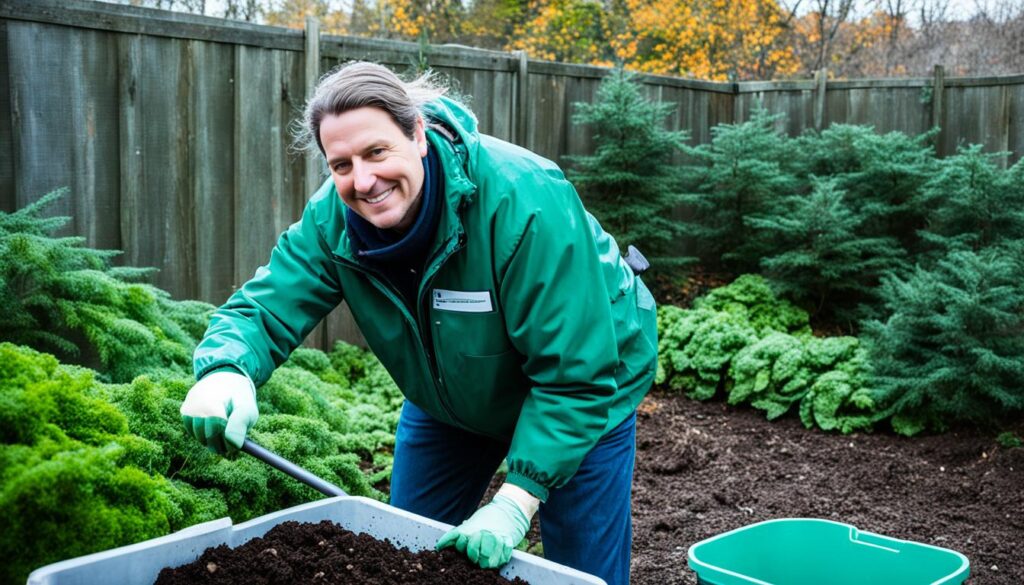
Preventing Excessive Mold Growth
Excessive mold growth in your compost pile can be a sign of an imbalance that needs to be addressed. By implementing preventive measures, you can reduce the occurrence of mold and maintain a healthy composting environment.
Compost Pile Aeration and Turnover
Aeration and turnover are essential for promoting a well-balanced compost pile and preventing excessive mold growth. Regularly turning your compost pile with a pitchfork or compost aerator helps to introduce oxygen into the mixture. This improves the decomposition process and discourages the proliferation of mold. Aim to turn the compost pile every few weeks, or whenever it starts to become compacted.
Moisture Management
Proper moisture management is crucial in preventing mold in compost. Moisture levels should ideally be around 40-60% – moist like a damp sponge. Excessive moisture can create a breeding ground for mold, while dry conditions can slow down decomposition. To manage moisture effectively, monitor the moisture content and adjust as needed. If the compost pile is too wet, add dry materials like straw or shredded leaves. In contrast, if it’s too dry, lightly water the pile to maintain adequate moisture levels.
Adding Dry Materials to Balance the Pile
A well-balanced compost pile helps prevent the growth of mold. Adding dry materials, often referred to as “browns,” helps balance the moisture content and provide carbon for the composting process. Dry materials include items such as dry leaves, shredded paper, and wood chips. Incorporating these materials into your compost pile helps create a balanced carbon-to-nitrogen ratio and discourages mold growth.
Addressing Common Mold Concerns for Gardeners
Gardeners often have specific concerns when it comes to mold in their compost. Understanding and addressing these concerns is essential for maintaining a healthy composting system. In this section, we will discuss common mold concerns for gardeners and provide guidance on mold control in composting. We will also explore how to spot red flags, particularly mold overgrowth, which can indicate potential issues in your compost pile.
Mold Control in Composting
To effectively control mold in composting, it is important to take preventive measures and implement proper management techniques. Here are some strategies you can follow:
- Aerate the compost pile regularly: By turning the compost pile, you increase airflow and create an oxygen-rich environment, which helps control mold growth.
- Monitor moisture levels: Mold thrives in moist environments. Keep a check on the moisture levels in your compost pile and ensure it remains moist but not waterlogged. Adjust moisture by adding dry materials or watering when needed.
- Balance the compost ingredients: An imbalanced compost pile, such as one with excessive green materials, can lead to mold overgrowth. Maintain a proper balance of carbon-rich brown materials and nitrogen-rich green materials.
- Avoid adding diseased or moldy plants: Introducing diseased or moldy plants into your compost pile can contribute to mold growth. Dispose of these materials separately.
- Cover the compost pile: Using a tarp or cover can help regulate moisture levels and prevent excess rainfall from saturating the pile, reducing the risk of mold growth.
Implementing these control measures can help you maintain a healthy compost pile with controlled mold growth.
Spotting Red Flags: Mold Overgrowth
Mold overgrowth in compost can indicate potential issues that need to be addressed. Here are some signs and red flags to watch out for:
- Strong, unpleasant odor: Excessive mold growth can lead to a foul smell emanating from the compost pile.
- Visible mold on the surface: If you notice a thick layer of mold covering the compost pile, it may indicate excessive mold growth.
- Persistent moisture issues: A consistently wet and saturated compost pile can provide an ideal environment for mold to thrive.
- Lack of decomposition progress: If your compost pile is not breaking down properly and the organic materials are not decomposing as expected, it could be due to mold overgrowth.
If you observe any of these red flags, it’s important to take action to address the mold overgrowth and restore a healthy composting process.

Ensuring Safe Interaction with Compost Mold
While mold in compost is a natural part of the process, it’s important to take precautions to ensure safe interaction with it. This section will provide guidelines and protective measures for handling moldy compost, as well as discuss the risks to human health from exposure to compost mold. Additionally, it will provide tips on keeping pets safe around compost.
Protective Measures for Handling Moldy Compost
When handling moldy compost, it is essential to protect yourself to minimize the risk of exposure. Follow these protective measures:
- Wear gloves and a dust mask when working with moldy compost to avoid direct contact and inhalation of mold spores.
- Avoid touching your face or eyes while handling moldy compost.
- Work in a well-ventilated area or wear a respirator if you are sensitive to mold.
- Wash your hands thoroughly with soap and water after handling moldy compost.
Risks to Human Health
Exposure to compost mold can potentially pose risks to human health, especially for individuals with respiratory issues or compromised immune systems. Some risks include:
- Allergic reactions: Inhalation or contact with mold spores can trigger allergies and respiratory symptoms, such as sneezing, coughing, wheezing, or skin rashes.
- Asthma exacerbation: Mold spores can aggravate asthma symptoms in individuals who are already asthmatic.
- Infections: Although rare, some molds in compost have the potential to cause infections in individuals with weakened immune systems.
If you experience persistent or severe symptoms after handling moldy compost, seek medical advice.
Keeping Pets Safe Around Compost
Pets are naturally curious and may be attracted to moldy compost. To protect your pets, consider the following:
- Avoid letting pets roam freely around the compost pile.
- Secure the compost pile with a cover or a fence to prevent pets from accessing it.
- Discourage pets from eating or digging in the compost.
- Monitor your pets for any signs of illness after contact with compost mold.
By following these guidelines, you can ensure the safe handling of moldy compost and minimize potential risks to human health and pets.
The Do’s and Don’ts of Composting Moldy Materials
Composting moldy materials can be a beneficial practice, but it’s important to follow certain guidelines to ensure successful composting. Here are some do’s and don’ts to keep in mind when composting moldy organic matter:
- Do: Assess the condition of the moldy material before adding it to your compost pile. If it’s only slightly moldy, you can typically add it without any issues.
- Do: Break down large pieces of moldy food or organic matter into smaller bits. This will help speed up the decomposition process and prevent clumping in the compost pile.
- Do: Mix the moldy materials well into the existing compost. This will help distribute the mold spores evenly and ensure proper breakdown.
- Don’t: Add excessive amounts of moldy organic matter to your compost. Too much moldy material can create an imbalance in the compost pile and lead to issues such as foul odors or slow decomposition.
- Don’t: Use moldy materials that have been treated with chemicals or pesticides. These substances can interfere with the composting process and harm beneficial organisms.
- Don’t: Compost moldy materials that have a foul odor, as this could indicate a potential health risk or contamination.
By following these do’s and don’ts, you can incorporate moldy organic matter into your compost pile responsibly and maximize its benefits for nutrient-rich compost.
Best Practices for Compost Mold Removal
If you’re facing mold issues in your compost, it’s important to take the right approach to remove it effectively. Mold removal not only mitigates the problem but also helps create an ideal compost environment that discourages future mold growth. Here are some tips for successful compost mold removal:
Tips for Mold Mitigation
- Regularly inspect your compost pile for signs of mold growth.
- Wear gloves, a dust mask, and protective clothing when handling moldy compost.
- Remove any visible moldy material from the pile and dispose of it properly.
- Avoid adding excessively moldy or damp organic matter to your compost.
- Ensure proper aeration and moisture management in your compost pile to discourage mold growth.
- Consider turning or mixing your compost pile to promote air circulation and discourage mold.
Creating the Ideal Compost Environment to Discourage Mold
To discourage mold growth in your compost, it’s essential to create an environment that is less favorable for mold development. Here are some measures you can take:
- Ensure a balanced carbon-to-nitrogen ratio in your compost pile by adding a mixture of green and brown organic materials.
- Maintain proper moisture levels in your compost by regularly monitoring and adjusting as needed. The ideal moisture content is around 50-60%.
- Turn or mix your compost regularly to promote oxygen flow and create aerobic conditions that discourage mold growth.
- Avoid compacting your compost pile excessively to allow for proper airflow.
- Consider adding compost additives or inoculants that promote beneficial microbial activity and help suppress mold growth.
By following these best practices for compost mold removal and creating an ideal compost environment, you can effectively manage mold issues and maintain a healthy compost pile.
How Do I Handle Mold in My Compost – Conclusion
In conclusion, effectively managing mold in compost is essential for maintaining a healthy and productive compost pile. By implementing the right knowledge and techniques, you can tackle mold issues with confidence. Throughout this article, we have discussed various mold management tactics that can help you prevent excessive mold growth and address mold concerns in composting.
Remember, mold plays a vital role in the decomposition process of compost. It breaks down organic materials and contributes to the overall health of your compost pile. Understanding the different types of mold found in compost and identifying healthy mold versus mold that may indicate an imbalance in your pile is crucial.
By practicing regular maintenance, adjusting moisture levels, and managing the composting process, you can prevent mold overgrowth and ensure a balanced environment for beneficial organisms in your compost pile. Additionally, taking necessary precautions like wearing protective gear and keeping pets away from compost can help you interact safely with compost mold.
Composting moldy materials can be a valuable practice, but it’s important to follow the do’s and don’ts. By removing mold from your compost and creating an ideal compost environment that discourages future mold growth, you can maintain a productive composting ecosystem and reap the benefits of nutrient-rich compost for your plants.
